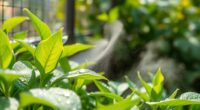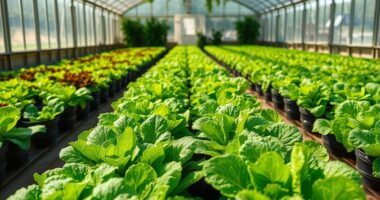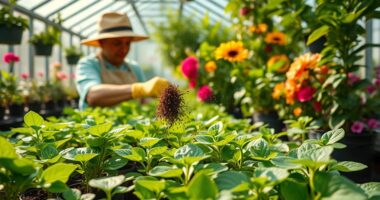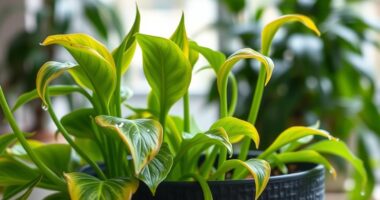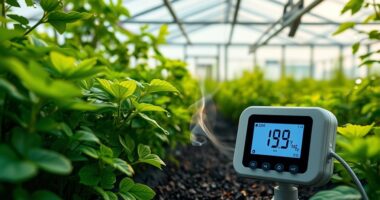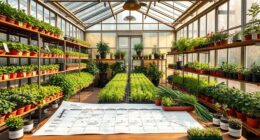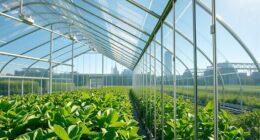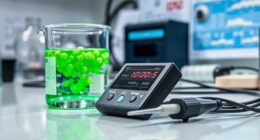To help your greenhouse plants bear fruit, guarantee proper pollination techniques like manually transferring pollen with soft brushes or gently shaking plants. Maintain ideal environmental conditions such as proper humidity, temperature, and airflow to support natural pollination. You can also use mechanical tools like vibrators or air blowers to distribute pollen evenly. Keeping pollinators healthy or supplementing with manual methods can boost fruit production—discover more tips to maximize your crop yield with continued effort.
Key Takeaways
- Use manual pollination techniques like gentle shaking or soft brushes to transfer pollen between flowers.
- Introduce healthy, disease-free pollinators such as bees if suitable for your crop.
- Maintain optimal environmental conditions—proper humidity, temperature, and airflow—to support natural pollination.
- Employ mechanical tools like vibrators or air blowers to evenly distribute pollen in large-scale greenhouse setups.
- Monitor and support pollinator health through nutrition, reducing stress, and creating a conducive environment for natural pollination.

Pollination in a greenhouse is a crucial step to guarantee healthy fruit and seed production, especially when natural pollinators like bees are absent or limited. Without effective pollination, your plants may produce fewer or deformed fruits, which can impact your harvest quality and quantity. To improve your success rate, you need to understand and implement proper pollination techniques. These methods can range from manual transfer of pollen to using specialized equipment that mimics natural pollination processes. For example, gently shaking plants or using a soft brush to transfer pollen from male to female flowers can substantially boost fruit set in a confined environment. These techniques are especially useful when natural pollinator activity is low or nonexistent inside the greenhouse.
Effective greenhouse pollination boosts fruit and seed production when natural pollinators are limited.
Managing pollinator health is equally important, even if you’re relying on manual or mechanical methods. If you choose to introduce pollinators like bees into your greenhouse, you must ensure they are healthy and free from diseases. A healthy pollinator population can greatly increase pollination efficiency, leading to better fruit development. Regularly monitor your pollinators for signs of stress or illness, and provide appropriate nutrition, such as supplemental feeding or pollen sources, to keep them active and productive. If you’re not using insects, focus on creating a conducive environment for self-pollinating plants or those that can be pollinated through wind or other means. Maintaining proper humidity, temperature, and airflow can facilitate natural pollination processes, even without external agents.
Additionally, understanding the impact of contrast ratio on image quality can help you create a more visually appealing display for your greenhouse’s signage or educational materials, making your setup more engaging for visitors.
In addition to manual techniques and managing pollinator health, technology can play a role in optimizing pollination in your greenhouse. Automated tools like vibrators or air blowers can help dislodge pollen and distribute it evenly across flowers. Using these devices can save time and increase consistency, especially in large-scale operations. Keep in mind that choosing the right pollination techniques depends on the specific crops you’re growing. For instance, tomatoes and peppers often benefit from vibration or manual shaking, while berries might require more direct pollen transfer. Always tailor your approach to the plant species’ natural pollination habits to maximize fruit production.
Ultimately, successful pollination in a greenhouse hinges on your ability to combine effective pollination techniques with proper management of pollinator health—whether you’re relying on insects or manual methods. When you pay close attention to these factors, you’ll create an environment that supports robust fruit and seed development, ensuring a healthy and productive harvest season.
Frequently Asked Questions
Can I Use Natural Pollinators Inside a Greenhouse?
You can definitely use natural pollinators inside a greenhouse to promote natural pollination, supporting your greenhouse ecosystem. Introducing bees, bumblebees, or other insects can effectively transfer pollen between flowers, increasing fruit production. Make certain your greenhouse has a welcoming environment for these pollinators, with access to the outdoors if possible, and avoid using pesticides that could harm them. This natural approach helps maintain a healthy, balanced ecosystem inside your greenhouse.
How Often Should I Hand-Pollinate My Greenhouse Plants?
They say, “A stitch in time saves nine,” and the same applies to pollination. You should hand-pollinate your greenhouse plants daily or every other day during peak flowering to guarantee good fruit set. Focus on pollination timing and frequency, especially if natural pollinators are absent. Regularly checking your plants’ blossoms and gently transferring pollen can make a big difference in successful fruiting.
What Tools Are Best for Manual Pollination?
You should choose tools that mimic natural pollination techniques, like small brushes or cotton swabs, to transfer pollen effectively. These tools act as pollinator alternatives when natural pollinators aren’t available. A gentle touch is key; avoid damaging delicate flowers. Using a soft paintbrush or a small electric toothbrush can also work well. These methods help guarantee successful pollination and fruit development, especially in controlled greenhouse environments.
Are There Specific Plants That Need More Pollination?
Some plants do need more pollination to maximize flowering enhancement and fruit production. Fruits like tomatoes, peppers, and cucumbers rely heavily on effective pollination techniques. You should pay extra attention to these, ensuring they receive adequate pollination through manual methods or natural agents. Using tools like brushes or fans can improve pollination success, especially when natural pollinators are limited, boosting flowering and fruiting in your greenhouse.
How Can I Identify Pollination Problems Early?
You might think your plants are thriving until they suddenly don’t bear fruit—classic pollination failure. To catch early detection, watch for flowers that drop early or don’t develop into fruit. No fruit? It’s a sign you missed the signs of pollination issues. Keep an eye on flower activity and pollen transfer; catching problems early means you can step in before it’s too late, saving your harvest.
Conclusion
By understanding and supporting pollination in your greenhouse, you can boost fruit production naturally. Some believe that introducing gentle insect visitors or manually pollinating can mimic nature’s process effectively. While these methods work well, it’s worth noting that encouraging natural pollinators like bees often leads to the best results. So, create a welcoming environment for them, and you’ll see healthier, more fruitful plants—proving that working with nature truly pays off.

